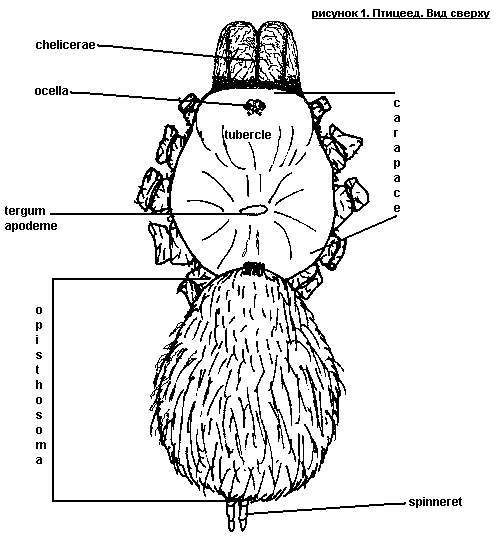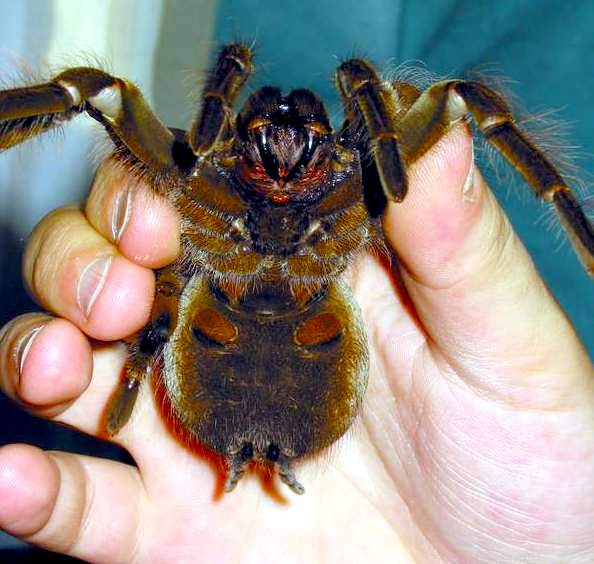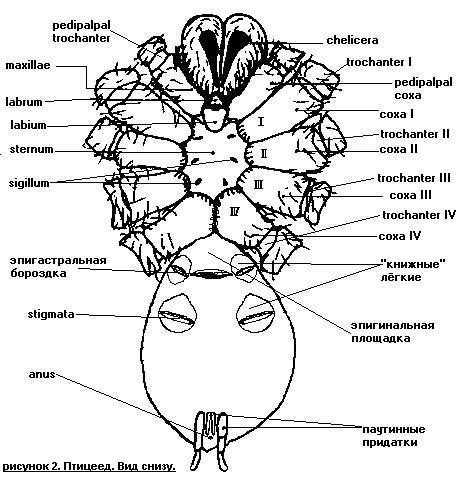External anatomy.
The body of tarantula conditionally possible divides into two parts – prosoma (cephalothorax) and opisthosoma (abdomen), united between itself small jumper – pedicel.
Overhand all body of spider is covered thick, enough hard shell – exoskeleton, presenting itself of chitinized cuticle with layer of underlying cells – hypodermis. Most the hard cuticle inheres in claws and chelicerae, the least hard, rubber-band cuticle is formed in the joints of legs. Exoskeleton executes the different functions: strictly skeleton, to which is attached majority of muscles; it serves the buffer between organism of spider and surrounding ambience, preventing its from quick loss of moisture, as well as protecting gentile internal organs from mechanical influences. Also exoskeleton carries on itself a lots of setae and hairs, executing sensor, touch and other (for instance, defensive) of function. Main and important element, forming exoskeleton spider – chitin (nitric polysaccharide), which in connection with sclerotin (protein) provides its toughness.
Prosoma (cephalothorax), probably, the most important and functional part of body of spider since in it is disposed ganglion (brain) пof spider and the main muscles (in particular, of sucking stomach and muscles, have charge of movement and controlling by chelicerae). Its also carries on itself chelicerae and basal segments of limbs of spider – сoxa. From the above prosoma covered with unadulterated dashboard– сarapace, at the anterior part (tubercle ) of which lays an eyes (ocelli), four pairs. Carapace has middle pressing in - ( tergal аpodeme), to which fasten the muscles.

With lower sides of prosoma, opposite carapace, inheres the breastbone sternum, in lower part which are located two cells – sigilli, functions which hitherto are not realised. In front part of sternum, in base of chelicerae, there are two still segments (so-called lower and upper "lips") – labium (rostrum) and labrum. Of the sides carapace and sternum are limited by basal segments of legs (сoxa). All these parts are united between it by flexible rubber-band membranes (pleurae) and cover thick cover of setae and hairs.
 Opisthosoma (abdomen) also has greater importance in tarantula organizations and concludes in itself organs, executing digestive, reproductive, as well as rest functions of its organism. From below, in base of the opisthosoma, inheres epiginal platform - (epiginum), wrought from remaining part of the abdomen frontal by pedicel, and at the behind by epiginal groove, disposed between first pair of "book lungs" which separated below the medium, for which follows the second pair of "book lungs", having similar construction. On the end of tarantula abdomen it is located two-paired silk-producing appendages (spinneret) and anus.
Opisthosoma (abdomen) also has greater importance in tarantula organizations and concludes in itself organs, executing digestive, reproductive, as well as rest functions of its organism. From below, in base of the opisthosoma, inheres epiginal platform - (epiginum), wrought from remaining part of the abdomen frontal by pedicel, and at the behind by epiginal groove, disposed between first pair of "book lungs" which separated below the medium, for which follows the second pair of "book lungs", having similar construction. On the end of tarantula abdomen it is located two-paired silk-producing appendages (spinneret) and anus.
Appendages. The body of spider has 8 pairs of appurtenances (appendages). First pair of appurtenances, horizontally prominent in front parts of body, calls сhelicerae. Each of these appurtenances consists of two segments, talon-like external one («tooth») which falls into groove of main segment (as blade of folding knife). The channel of poisonous ferric is opened on the end of each tooth. By chelicerae tarantula catch meal, chew it, drag over the cocoons, protected from enemies, help itself under digging burrows and so on.

Following pair of appurtenances, disposed next to chelicerae, – рedipalp, which though and looks like leg, but much shorter, have only one claw and do not execute the motor functions, but also serves the organs of sense of touch. Beside adult males pedipalps are mutated in connection with their copulative function the apical segments are transformed in copulative organs (сymbium). Each pedipalp consists of seed of tubular segments, united with each other the rubber-band membranes, last from which carries on the end two bunches of setae (toe pads) and claw. Starts from the base they're: coxa (I), trochanter (II), femur (III), patella (IV), tibia (V) tarsus (VI) and pretarsus.
Four pairs of walking legs follow after pedipalps, each of which has also seven segments. Unlike pedipalp the apical walking leg segment has two claws, and also sixth segment (tarsus) is divided into two pseudosegments – basitarsus and telotarsus. Beside adult males of many species of tarantulas the underside of fifth segment of first (once in a while -of second) pair of walking legs carries the spur (hook), employee for deduction of females chelicerae during mating.
The legs, either as tarantula pedipalps, covered by different sort of hairs and setae, which big part executes olfactory and sensory function. However, rows of setae disposed on segments VI and VII and often having metallic low tide, are grouped in special formation - scopulae and allow the heavy spider to climb on smooth glass surfaces.
The last, single appurtenance disposed on the end of abdomen – spinneret (silk appendages). All tarantulas have two pairs of such appendages: one of which practically is not seen and looks like the pair of hardly seen tubercles, back pair is well developed in the manner of lengthened appendages. Both pairs produce the web, connected with silk-producing glands, occupying much part inside abdomen. Web of spiders is close on its chemical composition to silk of silkworms (differs the less share sticking materials - sericin). The base of web structure forms proteid fibroin, formed by complex of albumin, glutamin acid and alfa-alanin.